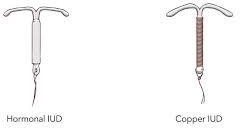A nurse in a clinic is discussing contraceptive methods with a client. Which of the following methods should the nurse recommend as having the lowest failure rate?
Intrauterine device
Diaphragm
Oral contraceptives
Contraceptive sponge
The Correct Answer is A
A) Correct- Intrauterine devices (IUDs) have one of the lowest failure rates among contraceptive methods. They are highly effective at preventing pregnancy.
B) Incorrect- Diaphragms have a higher failure rate compared to IUDs.
C) Incorrect- Oral contraceptives have a failure rate slightly higher than IUDs due to the potential for missed doses.
D) Incorrect- Contraceptive sponges have a higher failure rate compared to IUDs.

Nursing Test Bank
Naxlex Comprehensive Predictor Exams
Related Questions
Correct Answer is B
Explanation
A) Incorrect- A 20-gauge needle is too large and could cause unnecessary pain for the newborn.
B) Correct - Choosing a 3/8-inch needle is appropriate for administering vaccines to newborns. he hepatitis B vaccine is given intramuscularly in the anterolateral thigh of newborns. The needle size should be appropriate for the muscle mass and age of the infant. A 3/8-inch needle is recommended for newborns, while a 20-gauge needle is too large and may cause tissue damage.
C) Incorrect- Administering the vaccine into the dorsal gluteal muscle is not recommended because of the risk of injury to the sciatic nerve; the recommended site is the vastus lateralis muscle in the anterolateral thigh.
D) Incorrect- The hepatitis B vaccine is usually administered in a dose of 0.5 mL for newborns, but this is not the only action that the nurse should take.
Correct Answer is C
Explanation
A) Incorrect- Administering medication into the deltoid muscle is not typically done in newborns. Phytonadione is given intramuscularly, usually in the vastus lateralis muscle, not the deltoid muscle.
B) Incorrect- Phytonadione should be given within 1 hour of birth, not 12 hours after birth. Delaying the administration increases the risk of bleeding complications.
C) Correct- The size of the needle is important for the newborn's comfort, A 25-gauge needle is the appropriate size for administering phytonadione to a newborn. A smaller needle may not deliver the medication adequately, and a larger needle may cause more tissue damage and bleeding.
D) Incorrect- The mother's Rh factor is irrelevant for the administration of phytonadione.
Rh factor affects the risk of hemolytic disease in the newborn, which is a different condition from hemorrhagic disease.

Whether you are a student looking to ace your exams or a practicing nurse seeking to enhance your expertise , our nursing education contents will empower you with the confidence and competence to make a difference in the lives of patients and become a respected leader in the healthcare field.
Visit Naxlex, invest in your future and unlock endless possibilities with our unparalleled nursing education contents today
Report Wrong Answer on the Current Question
Do you disagree with the answer? If yes, what is your expected answer? Explain.
Kindly be descriptive with the issue you are facing.
